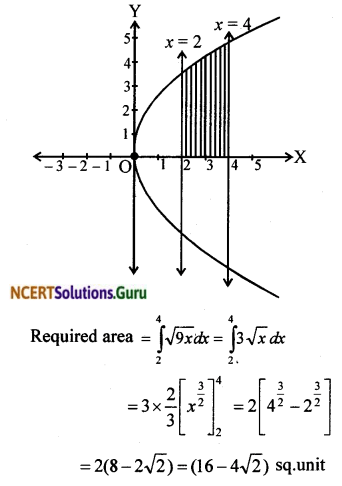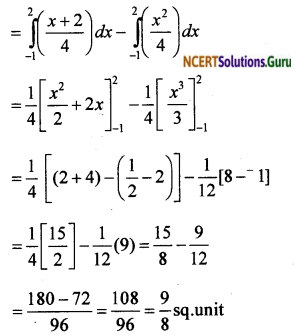NCERT Solutions for Class 12 Maths Chapter 8 Application of Integrals Ex 8.2
These NCERT Solutions for Class 12 Maths Chapter 8 Application of Integrals Ex 8.2 Questions and Answers are prepared by our highly skilled subject experts. https://mcq-questions.com/ncert-solutions-for-class-12-maths-chapter-8-ex-8-2/
NCERT Solutions for Class 12 Maths Chapter 8 Application of Integrals Exercise 8.2
![]()
Ex 8.2 Class 12 NCERT Solutions Question 1.
Find the area of the circle 4x² + 4y² = 9 which is interior to the parabola x² = 4y.
Solution:

4x² + 4y² = 9
∴ x² + y² = \(\frac { 9 }{ 4 }\) … (1) is a circle with
centre (0,0) and radius = \(\frac { 3 }{ 2 }\)
x² = 4y … (2)
Substituting (2) in (1), we get 4y + y²
⇒ 4y² + 16y – 9 = 0
⇒ 4y² – 2y + 18y – 9 = 0
⇒ 2y(2y – 1) + 9(2y – 1) = 0
⇒ (2y – 1)(2y + 9) = 0
⇒ y = \(\frac { 1 }{ 2 }\), y = \(\frac { – 9 }{ 2 }\)
∴ y = \(\frac { 1 }{ 2 }\)
Substitute y = \(\frac { 1 }{ 2 }\) in (2) we get x = ± \(\sqrt{2}\)
∴ The point of intersection of the curves are (- \(\sqrt{2}\), \(\frac { 1 }{ 2 }\)) and (\(\sqrt{2}\), \(\frac { 1 }{ 2 }\))
Since the shaded region is symmetric with respect to y-axis,
Required Area = 2[Area under the circle – Area under the parabola] lying in the first quadrant between the lines x = 0 and x = \(\sqrt{2}\)

Exercise 8.2 Class 12 NCERT Solutions Question 2.
Find the area bounded by curves (x – 1)² + y² = 1 and x² + y² = 1.
Solution:

x² + y² = 1 is a circle with centre at origin and intersecting positive x-axis at (1, 0).
(x – 1)² + y = 1 is a circle with centre at the origin and passing through the origin.
Solving x² + y² = 1 and (x – 1)² + y² = 1,
we get x² – (x – 1)² = 0
(x – x + 1)(x + x – 1) = 0
2x – 1 = 0
∴ x = \(\frac { 1 }{ 2 }\)
When x = \(\frac { 1 }{ 2 }\), we get (\(\frac { 1 }{ 2 }\))² + y² = 1
y² = \(\frac { 3 }{ 4 }\)
∴ y = \(\frac{\pm \sqrt{3}}{2}\)
Hence the points of intersection of the two circles are (\(\frac { 1 }{ 2 }\), \(\frac{\pm \sqrt{3}}{2}\)) and (\(\frac { 1 }{ 2 }\), \(\frac{\pm \sqrt{- 3}}{2}\)).
The area bounded by the two curves is sym-metric w.r.t. x-axis.
∴ Required area = 2 x shaded area … (1)
Area of shaded region = Area under arc OA + Area under arc AC

![]()
8.2 Class 12 NCERT Solutions Question 3.
Find the area of the region bounded by the curves y = x² + 2, y = x, x = 0 and x = 3.
Solution:
Equation of the parabola is y = x² + 2 or x² = (y – 2)
Its vertex is (0,2) axis is y-axis.
Boundary lines are y = x, x = 0, x = 3.
Graphs of the curve and lines have been shown in the figure.
Area of the region PQRO = Area of the region OAQR – Area of region OAP

Ex 8.2 Class 12 Maths Ncert Solutions Question 4.
Using integration find the area of region bounded by the triangle whose vertices are (-1, 0), (1, 3) and (3, 2).
Solution:
Let the vertices of the triangle are A(- 1, 0), B(1, 3) and C(3, 2).

Equation of AB is y – 0 = \(\frac { 3 – 0 }{ 1+1 }\)(x+1)
i.e, y = \(\frac { 3 }{ 2 }\)(x + 1)
Equation of BC is y – 3 = \(\frac { 2 – 3 }{ 3 – 1 }\)(x – 1)
i.e, y – 3 = \(\frac { – 1 }{ 2 }\)(x – 1) ∴ y = \(\frac { 7 – x }{ 2 }\)
Equation of AC is y – 0 = \(\frac { 2 – 0 }{ 3 + 1 }\) (x + 1)
i.e., y = \(\frac { 1 }{ 2 }\)(x + 1)
Area of ∆ ABC = Area of ∆ ADB + Area of trapezium BDEC – Area of ∆ AEC

![]()
Exercise 8.2 Class 12 Maths Ncert Solutions Question 5.
Using integration find the area of the triangular region whose sides have the equations y = 2x + 1,y = 3x + 1 and x = 4.
Solution:
The equations of sides of the triangle are
y = 2x+ 1 … (1), y = 3x + 1 … (2), x = 4 … (3)
Solving equations (1) and (2), we get x = 0 and y = 1
Let A be the point (0,1)
Solving equations (1) and (3), we get x = 4 and y = 9.
Let B be the point (4, 9) Solving equations (2) and (3) we get x = 4 and y = 13
Let C be the point (4, 13)

Ex 8.2 Class12 NCERT Solutions Question 6.
Smaller area bounded by the circle x² + y² = 4 and the line x + y = 2
(a) 2 (π – 2)
(b) π – 2
(c) 2π – 1
(d) 2(π + 2)
Solution:
x² + y² = 4 intersects the positive x-axis at (2, 0) and the positive y-axis at (0, 2). The line x + y = 2 passes through (2, 0) and (0, 2).

Required area is shaded in the figure. Required Area = (Area of circle – Area under the line) lying in the first quadrant

![]()
Ex 8.2 Class 12 Ncert Solutions Question 7.
Area lying between the curves y² = 4x and y = 2x.
(a) \(\frac { 2 }{ 3 }\)
(b) \(\frac { 1 }{ 3 }\)
(c) \(\frac { 1 }{ 4 }\)
(d) \(\frac { 3 }{ 4 }\)
Solution:
(b) \(\frac { 1 }{ 3 }\)

The given curves are y² = 4x … (1)
y = 2x … (2)
4x(x – 1) = 0 ⇒ x = 0, x = 1
When x = 0, y = 0
When x = 1, y = 2
The points of intersection are (0, 0) and (1, 2)
Required area is shaded in the figure.

NCERT Solutions for Class 12 Maths Chapter 8 Application of Integrals Ex 8.2 Read More »























































































